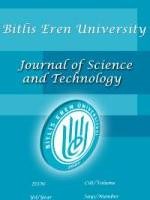Structural Analysis of Ahlat Emir Bayındır Bridge
Structural Analysis of Ahlat Emir Bayındır Bridge
Ahlat Structural analysis, Emir Bayındır Bridge, Seismic behavior,
___
- Backer, L.D., Janssens, A., Steeman, M., Paepe, M.D., 2018. Evaluation of display conditions of the Ghent altarpiece at St. Bavo Cathedral. Journal of Cultural Heritage 29, 168–172
- Bakış, A., Işık, E., Hattatoğlu, F., Akıllı, A., 2014. Use of the geological heritage qualified Ahlatstone in construction industry, III.International Symposium on Culture and Art of the Ahlat-Avrasya, Bitlis, Turkey.
- Beygu A.Ş. 1932. Ahlat Kitabeleri. İstanbul.
- Computers and Structures, 2011. SAP 2000 V14.0.0 Software, Structural Analysis Program
- Çulpan, C., 1975. Türk Taş Köprüleri, Ankara.
- Dabanlı. Ö., 2008. Tarihi yığma yapıların deprem performansının belirlenmesi, Yüksek Lisans Tezi, İstanbul Teknik Üniversitesi, İstanbul.
- Dhanasekar, M., Haider, W., 2008. Explicit finite element analysis of lightly reinforced masonry shear walls. Computers & Structures, 86(1), 15-26.
- Erdil, B.,Tapan, M., Akkaya, İ., Korkut, F., 2018. Effects of structural parameters on seismic behaviour of historical masonry minaret, Periodica Polytechnica. Civil Engineering, 62(1), 148-161.
- Giordano, A., Mele, E., De Luca, A., 2002. Modelling of historical masonry structures: comparison of different approaches through a case study. Engineering Structures, 24(8), 1057-1069.
- Hadzima-Nyarko, M., Mišetić, V., Morić. D., 2017. Seismic vulnerability assessment of an old historical masonry building in Osijek, Croatia, using Damage Index. Journal of Cultural Heritage, 28, 140-150.
- Hadzima-Nyarko, M., Pavić, G.,Lešić, M., 2016. Seismic vulnerability of old confined masonry buildings in Osijek, Croatia. Earthquakes and Structures, 11(4), 629-648.http://www.islamansiklopedisi.info/dia/pdf/c11/c110067.pdf (Access date:10.09.2017)
- https://www.kulturportali.gov.tr/turkiye/bitlis/kulturenvanteri/emr-bayindir-koprusu (Access date:10.09.2017)
- Işık, M.F., Işık, E., Ülker, M., 2016. “Establishment of urban memory system for Ahlat district, 1st International Mediterranaen Science and Engineering Congress, Adana, Turkey.
- Işık, E., Aydın, M.C., Ülker, M., 2016a. Performance evaluation of a historical tomb and seismicity of the region. Bitlis Eren University, Journal of Science and Technology, 6(2),59-65.
- Işık, E., Velioğlu, E., Öztürk, G., 2016b. Determination of seismic safety of a historic masonry building in Bitlis”, BEU Journal of Science, 5(1), 59-64.
- Işık, M.F., Işık, E., Bülbül, M.A.,Karaşin, İ.B., 2017. QR code application for geometric location and ınformation of historical structures. In International Conference on Advanced Engineering Technologies (ICADET 2017), Turkey.
- Işık, E., Antep, B., Büyüksaraç, A., Işık, M.F., 2018. Observation of Behavior of the Ahlat Grave Stones (TURKEY) at Seismic Risk and Their Recognition by the QR Code. unpublished article.
- Karaşin, İ.B., Işık, E., 2016. Protection of Ten-Eyed Bridge in Diyarbakır, Budownictwo i Architektura, 15(1), 87-94.
- Mutlu, Ö., Şahin, A., 2016. Investıgatıng the effect of modeling approaches on earthquake behavior of historical masonry minarets-Bursa Grand Mosque case study. Sigma, 7(2), 123-136.
- Nikoo, M., Hadzima-Nyarko, M., Khademi, F., Mohasseb, S. 2017. Estimation of fundamental period of reinforced concrete shear wall buildings using self organization feature map. Structural Engineering and Mechanics, 63, 237-249.
- Özbek, O., Akyıldız, M.H., Karaşin, A.H., Öncü, M.E., Çetin, S.Y., 2017. Assessment of multi-storey masonry buildings in Sur region according to Turkish Seismic Code 2007. DUMF Journal of Engineering, 8(2), 395-402.
- Preciado, A. Alejandro Ramirez-Gaytan, A., Salido-Ruiz, R.A.,Caro- Becerra, J.L.,Lujan-Godinez, R., 2015. Earthquake risk assessment methods of unreinforced masonry structures: hazard and vulnerability. Earthquakes and Structures, 9 (4), 719–733.
- Tabak N., 1972. Ahlat Türk Mimarisi, İstanbul.
- Turkish Earthquake Code (TEC) (2007)Turkish earthquake code-specification for structures to be built in disaster areas, Turkey.
- Uğurlu, M.A., Günaslan, S.E., Karaşin, A.H., 2017. Modelling and structural analysis of the Four-legged minaret. DUMF Journal of Engineering, 8(2), 413-421.
- Yayın Aralığı: Yılda 2 Sayı
- Başlangıç: 2011
- Yayıncı: Bitlis Eren Üniversitesi
Sepsis and Nursing Care in Pediatric Patients
Elastic scattering of 17F nuclei from 58Ni target: Comparison with three different models
Little Knowledgeable Mothers of Modern World: Diarrhea is an Important Public Health Problem
Eylem KUDAY KAYKISIZ, Ramazan GÜVEN, Mihriban SÖNMEZSOY, Ali TONGUN
Measurement of anxiety and depression level for nurses
Ayşegül ALKAN EZİN, Zeynep Şefika EKŞİOĞLU, Ramazan GÜVEN
Introduction to Wavelets and their applications in signal denoising
Cigdem POLAT, Mehmet Siraç ÖZERDEM
Can Patients with Appendicitis in Pregnancy be Operated in Secondary Hospital: A retrospective Study
Adnan BUDAK, Abdullah ŞENLİKÇİ, Ramazan GÜVEN
The Annual Change of Environmental Gamma Radiation in Bitlis
Sultan ŞAHİN BAL, Şule KARATEPE, Muhammed Fatih KULUÖZTÜRK, Engin YILMAZ, Murat KURŞAT
Structural Analysis of Ahlat Emir Bayındır Bridge
